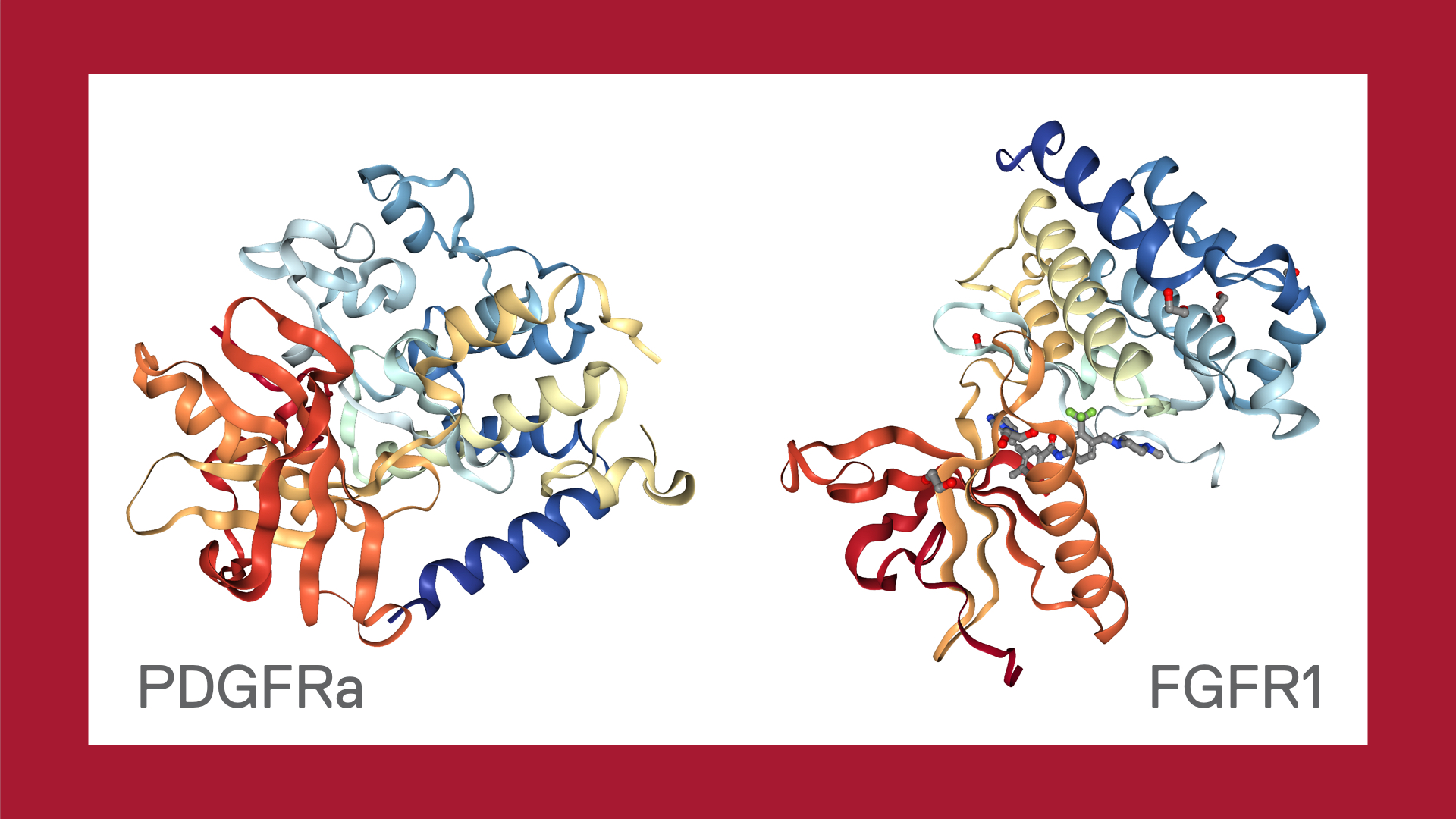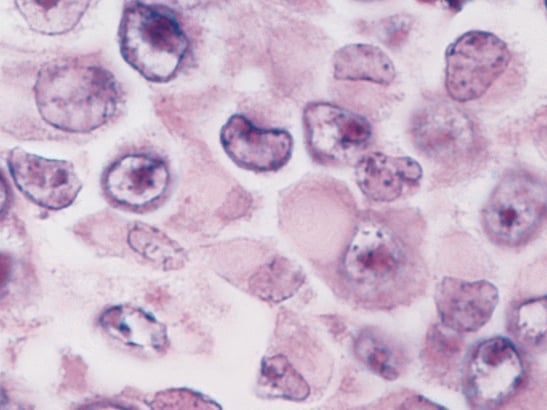
Protein structures of two receptor tyrosine kinases PDGFRa and FGFR1 (shown in complex with ponatinib), the genes of which exhibit increased expression in rhabdoid tumour patients. Structural information obtained from RSCB Protein Data Bank and visualized with the NGL protein viewer.
Scientists have identified a drug combination that could be effective against a childhood cancer for which there is no current cure.
Using cancer cells isolated in a laboratory, they identified a new way to target malignant rhabdoid tumours — a type of cancer that usually develops in the kidneys, and is most common in infants and toddlers.
Scientists at The Institute of Cancer Research, London, found important clues for why these cancers are so difficult to treat, and pointers to new targeted treatments that might be more effective and with fewer side-effects than chemotherapy.
The research was funded by the Institute of Cancer Research, Sarcoma UK and Cancer Research UK, and is published in the journal Cell Reports.
Identifying the genes that are active in tumours
Malignant rhabdoid tumours do not normally respond to standard chemotherapy and, when they do, they usually become resistant to treatment. The children who develop these cancers are usually just over a year old, and most die within a year of diagnosis.
The development of malignant rhabdoid tumours is triggered by mutations in or loss of a gene called SMARCB1 — but the gene cannot be targeted directly and its role in the progression of cancer is poorly understood.
The researchers investigated other genetic changes caused by SMARCB1 deficiency that could respond to treatment.
They identified two genes — called PDGFRA and FGFR1 — that were more active in patients with malignant rhabdoid tumours, and seemed to play an important role in driving growth of the cancers.
PDGFRA and FGFR1 belong to a class of genes that are essential for controlling signalling in cancer cells that stimulates uncontrolled growth.
The team found that the proteins produced by the PDGFRA and FGFR1 genes were present at high levels in malignant rhabdoid tumours.
Benefits of using a drug combination
In a lab study using cancer cells, they inhibited the proteins by targeting them with drugs that are in use or in development to treat other types of cancer. Inhibiting just one protein had little effect, but eliminating both — with drugs that could target them simultaneously — disrupted and ultimately killed cancer cells.
The results also explain why in most cases tumours become resistant to therapy, even if it works for a short time initially.
The drugs pazopanib, dasatinib and sunitinib were all successful at inhibiting the PDGFRA protein — but if high levels of the FGFR1 protein remained, the cancer returned and would not respond to treatment even at higher doses.
An existing drug called ponatinib, currently in use as treatment for leukaemia, can target both proteins at once. However, the safety of ponatinib in children has not been established, emphasising the need to screen for other drugs able to target both PDGFRA and FGFR1.
Other drug options are in early-phase clinical trials in adults and, if successful, could be evaluated against malignant rhabdoid tumours in children.
Cancer weaknesses can be targeted with drugs
Study leader Dr Paul Huang, Team Leader of the Protein Networks Team at the Institute of Cancer Research, London said: “The prognosis for infants with this type of cancer is dismal and we urgently need to find new ways to treat it.
“For the first time, we have identified weaknesses in this rare, devastating cancer that can be targeted with drugs. At the moment there are not many options for the children with malignant rhabdoid tumours but our findings give new pointers to doctors that could be used to shape treatment of patients.”
The next step in the research will be to test combinations of drugs, or new drugs that target both proteins, in mouse models of the disease, to provide the evidence needed to start a clinical trial.
The scientists suggest that if patients initially respond to treatment but become resistant, they could be assessed for levels of the FGFR1 protein. Those patients with high levels might benefit from drugs that inhibit FGFR1.
The need for more targeted cancer treatments
Professor Paul Workman, Chief Executive of the Institute of Cancer Research, London, said: “This study shows that a combination of two existing targeted drugs could treat malignant rhabdoid tumours – and is an example of the potential for tailored combinations of drugs to block signalling networks in many cancer types.
“It provides an exciting pointer for how we might treat more effectively an aggressive childhood cancer for which there is currently no cure. We need to see much better, more targeted treatments for children with cancer, that further drive up survival rates and spare children the serious long-term side-effects that conventional chemotherapy can cause.
“It’s crucial, when — as here — there is a strong scientific rationale for a new treatment approach in children, that we can assess them as rapidly as possible in clinical trials. At the moment, it’s much too easy for pharmaceutical companies to avoid evaluating their drugs in children, even when there is good evidence that they could benefit.”
Contributions to help progress the work can be made via our appeals and campaigns page.
